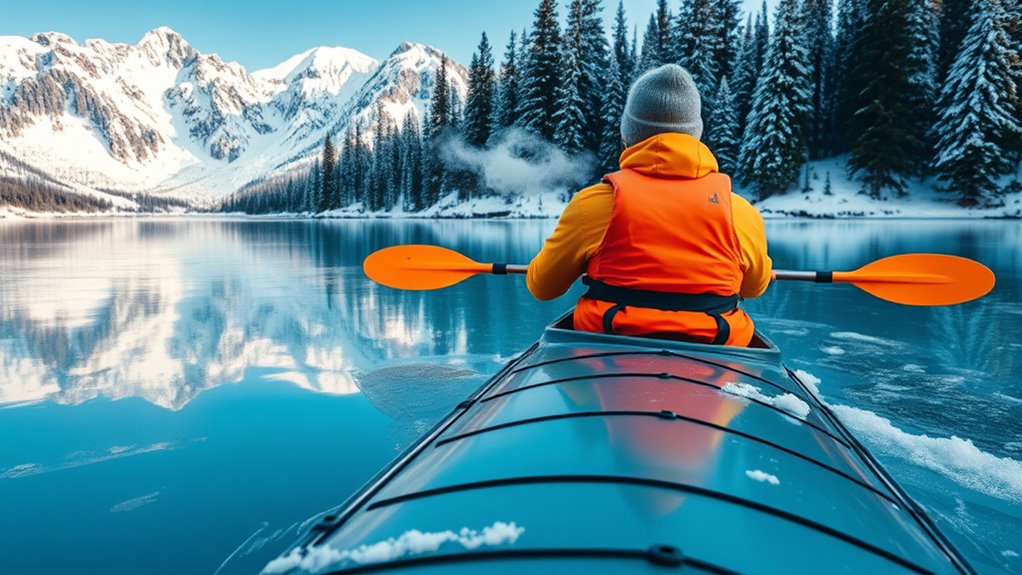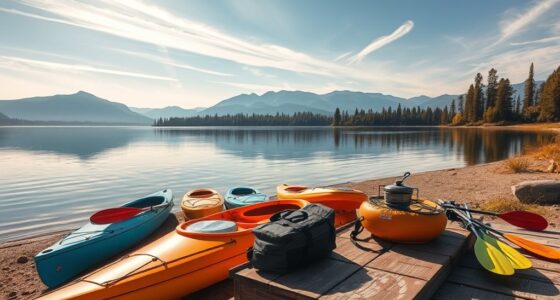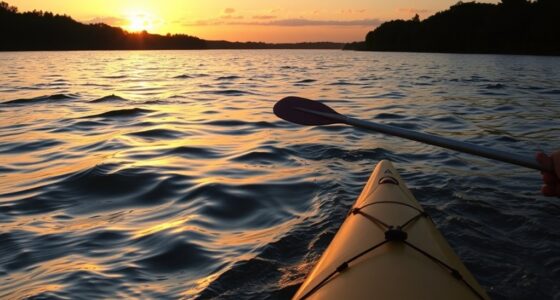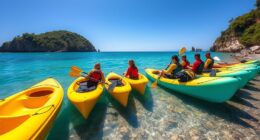Kayaking in winter requires you to prioritize cold weather gear and safety. Start by inspecting your kayak and gear for any damage. Dress in layers, using moisture-wicking bases, insulating layers, and waterproof outer shells. Always paddle with a buddy and stay aware of water temperatures. Keep your gear visible and accessible, and pack safety equipment like a whistle and first-aid kit. There’s much more you should know to stay safe and have fun on the water.
Key Takeaways
- Inspect your kayak for damage and ensure all seals are intact to maintain safety during winter paddling.
- Layer clothing with moisture-wicking base layers and waterproof outer shells to stay warm and dry.
- Use high-visibility paddles and gear to enhance spotting in snowy or frosty conditions.
- Always check water temperature and conditions, as cold water poses severe risks despite warmer air temperatures.
- Carry essential safety gear, including a whistle and first-aid kit, and kayak with a buddy for added security.
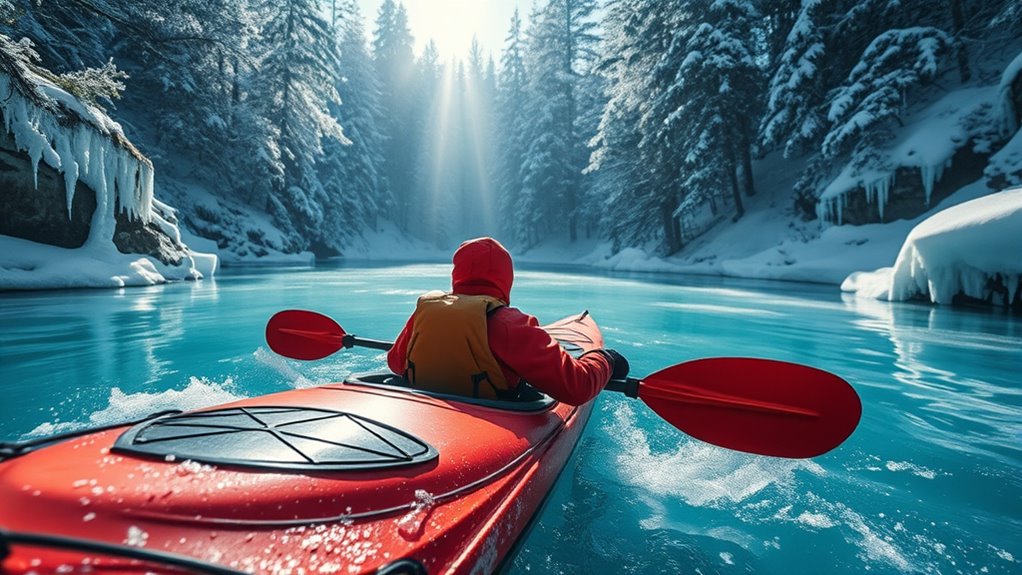
When winter blankets the landscape in a shimmering coat of snow and ice, kayaking might seem like an unlikely adventure. However, with the right preparation and mindset, you can embrace the serene beauty of cold water paddling. The key to enjoying this unique experience lies in understanding the challenges of winter weather and guaranteeing your gear is ready for action.
Before you hit the water, you’ll want to check your kayak and all associated gear carefully. Winter weather can be harsh, and your equipment needs to be in top shape to withstand the elements. Inspect your kayak for any cracks or damage that may have occurred during the warmer months. Pay special attention to the seals and hatches, as these areas can be particularly susceptible to wear and tear. A thorough gear maintenance routine not only ensures safety but also enhances your overall paddling experience.
Prioritize gear checks before winter kayaking; inspect for damage and ensure your equipment is ready for the harsh elements.
Don’t forget about your paddle. It’s essential to keep it free of ice and snow, which can create unwanted weight and make it difficult to maneuver. Consider using a paddle with a high-visibility color; this way, you’ll be more easily spotted in the frosty landscape should an emergency arise. Also, remember to wear gloves or mittens to keep your hands warm while you paddle.
Your clothing choice is crucial for staying comfortable in chilly conditions. Layering is your best friend; start with a moisture-wicking base layer, followed by an insulating layer, and finish with a waterproof and windproof outer shell. Don’t skimp on your feet—wear thick socks and waterproof boots to keep your toes toasty. A well-fitted dry suit can be a game-changer too, as it provides a protective barrier against the cold water. Color accuracy in your gear, like the visibility of your paddle and clothing, can significantly enhance safety in winter kayaking.
Safety should always be your top priority. Make sure you’re aware of the water temperature and conditions before heading out. Cold water can be deceptive; even if the air temperature feels manageable, the water can pose severe risks. It’s wise to kayak with a buddy or at least inform someone of your plans. Carrying safety gear, like a whistle, a first-aid kit, and a throw rope, is essential.
Frequently Asked Questions
Can I Kayak in Frozen Lakes or Rivers?
You shouldn’t kayak in frozen lakes or rivers. Ice formation creates dangerous conditions, making it easy to capsize or get trapped. If you’re considering paddling in winter, stick to open water. Always wear thermal clothing to stay warm and protected from the cold. Stay alert for changing weather and make sure your safety gear is accessible. Your safety’s the priority, so choose wisely and avoid risky frozen waters.
What Type of Kayak Is Best for Winter Conditions?
When it comes to winter kayaking, you need a kayak that excels in stability and storage solutions. Look for a wider hull design that enhances stability on icy waters, ensuring you stay upright. A good storage system is essential too, allowing you to secure gear and keep it dry. As you venture out, think about how these features can make your experience both safer and more enjoyable. Are you ready to explore?
How Do I Prevent My Gear From Freezing?
To prevent your gear from freezing, focus on thermal insulation and gear maintenance. Use insulated bags for your gear, and keep your paddles and personal items close to your body to retain warmth. Regularly check for any moisture buildup, and dry everything thoroughly after use. If temperatures drop markedly, consider using gear specifically designed for cold weather, which can help keep your equipment functional and safe during those chilly outings.
Are There Specific Winter Kayaking Regulations to Follow?
Just like a snowflake dances on the wind, winter kayaking comes with its own set of regulations. You should always wear proper winter clothing and guarantee your safety equipment is up to date. Check local laws for any specific requirements, such as wearing a personal flotation device or having a whistle. Following these guidelines keeps you safe and compliant, allowing you to enjoy the serene beauty of winter waters without worry.
What Should I Do if I Capsize in Cold Water?
If you capsize in cold water, stay calm and focus on hypothermia prevention. Try to get back on your kayak or grab onto it. If you can’t, perform the HELP position—hug your knees to your chest to conserve body heat. Signal for help using your whistle or any visible means. Employ rescue techniques by keeping your head above water and moving towards safety as quickly as possible, without exhausting yourself.
Conclusion
So, embrace the chill, gear up for the thrill, and paddle with skill. Winter kayaking offers unique beauty and excitement, but safety and preparation are key. Equip yourself with the right cold weather gear, stay aware of the conditions, and always prioritize your well-being. With the right mindset and precautions, you can enjoy the serene waters and breathtaking landscapes that winter has to offer. Get out there, explore the cold, and make unforgettable memories on the water!

